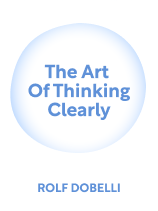

This article is an excerpt from the Shortform book guide to "The Art of Thinking Clearly" by Rolf Dobelli. Shortform has the world's best summaries and analyses of books you should be reading.
Like this article? Sign up for a free trial here .
What is liking bias? Have you ever used the likeability factor to sway someone towards a decision?
Liking bias is the tendency to grant requests from people you know and like. This bias is often used in sales to influence purchasing decisions.
Keep reading to learn about the psychology behind liking bias and how it is used in marketing.
Liking Bias
The more you like someone, the more value you put on their opinions and desires. This means you’re more likely to do something for an individual you like.
Liking bias is frequently exploited in marketing. According to Dobelli, there are three main components to liking someone that are manipulated in marketing:
1. Physical attractiveness. You’re more likely to see attractive people as likable, which is why only attractive people appear in advertisements. (Shortform note: Attractiveness is subconsciously associated with good traits like kindness and generosity, which is why you’re more prone to like attractive people. However, the definition of “attractive” changes over time, meaning this subconscious standard of goodness—and the advertisements that take advantage of it—change just as quickly.)
2. Similarity. You find people who look, sound, or have experiences like you more likable. Marketers manipulate this through “mirroring”: purposefully mimicking other people’s behavior and speech patterns so the other person will like them and be more likely to purchase their products. (Shortform note: Mirroring might be manipulated by marketers, but it’s also used by minorities. For instance, black people often feel pressured to mirror their white counterparts to avoid prejudice. Studies show that minorities who change the way they speak, how they wear their hair, and sometimes even their name to fit in with their white counterparts are viewed as more professional and likable.)
3. They already like you. If someone is being friendly and makes it clear that they like you, you’re more likely to like them back. Marketers manipulate this tendency through flattery. (Shortform: It’s important to recognize when you’re being flattered because flattery’s goal is to control your behavior, not give you an honest compliment. You can identify flattery by paying attention to the circumstances in which someone compliments you. Do they only compliment you when they want something or when they know you can hear them? If so, they’re probably using flattery. Lessen flattery’s control over you by weighing the sincerity of someone’s compliments rather than how they make you feel.)
Dobelli suggests avoiding liking bias by separating the seller from the product. Would you purchase the product if the person selling it to you wasn’t there, or if they were unlikeable?
| Liking Bias and Alliances While Dobelli explains how people manipulate liking bias, he doesn’t say why liking someone makes you value them more. Some experts say it’s because when you like someone, you form an alliance with them. Having a common goal (friendship) unites you and the other person, making you more likely to value them and, as Dobelli says, fulfill their desires. The three methods Dobelli discusses all manipulate liking bias with the goal of forming alliances: Physical attractiveness is associated with goodness, as discussed above, and you want to form alliances with attractive, “good” people. Similarity takes advantage of you already being in one alliance with the other person—whether preferring the same sports team, being a member of the same race, or coming from the same city—to encourage you to form a different alliance with them. Flattery emphasizes that the other person wants to be in your group, rather than making you join theirs, giving you a self-esteem boost and making you more likely to agree to the alliance. Finally, Dobelli’s advice to avoid liking bias also operates on the alliance principle: Separating the seller from the product breaks the alliance. |

———End of Preview———
Like what you just read? Read the rest of the world's best book summary and analysis of Rolf Dobelli's "The Art of Thinking Clearly" at Shortform .
Here's what you'll find in our full The Art of Thinking Clearly summary :
- A detailed look at the most common logical fallacies that inhibit decision-making
- How to recognize and overcome these fallacies to make better decisions
- Why you value things for arbitrary reasons






